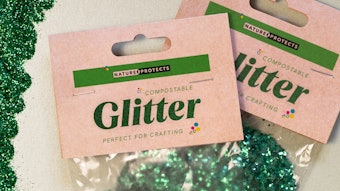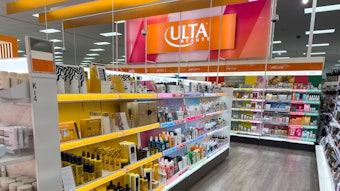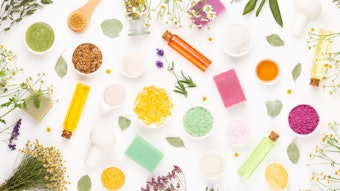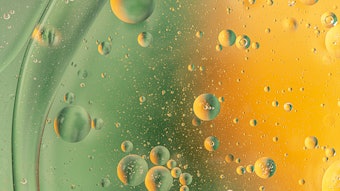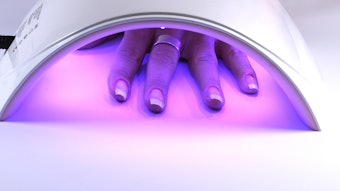- Beauty brands seeking to use organic ingredients in their products need to know their organic certification options, as well as where consumers are responding to organic products.
- Although challenges with ingredient supply, certifications and consumer awareness do exist for organic products, the viability of this market overshadows those surmountable concerns.
- Including organic ingredients in a beauty product significantly adds to a product’s marketing story, from the growers to the certification to the safety and beyond.
In the development of beauty products today, the inclusion of organic ingredients is an option that more and more brand owners are considering. With the natural trend on a continuing climb and more consumers seeking out products that aren’t genuinely natural, the relatively more regulated organic industry has drawn a lot of attention and interest. However, there are a variety of considerations when it comes to an organic beauty product—it isn’t as easy as just affixing a certification logo or adding “organic” to the name and calling it a day.
“When it comes to ingredients, the standard set forth by the U.S. government—and this is the USDA, the United States Department of Agriculture—has sort of taken this under its wing,” says David Fondots, vice president, sales and marketing, Extracts & Ingredients, Ltd. “Some years ago, the USDA established what is called the NOP program, which is the National Organic Program. Its purpose is to ensure the integrity of proclaimed organic products in the U.S. and also globally.”
However, the USDA Organic certification is sometimes seen as problematic for beauty brands and ingredients. “At the end of the day, when it comes to organic, you are going to find the organic law itself, the NOP, was originally written as a food standard. So the majority of allowable non organic ingredients are non-cosmetic,” comments Sundeep Gill, vice president, R&D, Sun Deep Cosmetics, Inc. “Very little has to do with cosmetics/personal care. It is actually engineered mostly for food, so many, many things you find on there are meant for baking, meant for agriculture, and they really have nothing to do with what we do here in personal care. We must search for similar technologies used in the organic food industry to give us the desired stability and usability that we demand in the personal care market.”
To address this challenge, other certification bodies have stepped up to develop their own organic standards. “There is actually an alphabet soup of standards out there, some claiming natural, some things like ‘made with organics,’ some doing things like biodynamic certification,” notes Gill. And one of the largest of these certifiers is NSF International. “NSF is a certifying body, and it decided to put something together, a standard, that says that if you hit this calculation of 70% organic ingredients in your product and your non-organic ingredients adhere to this very short list of what you can and can’t use in terms of how this ingredient is made, then you can go ahead and carry—not the USDA Organic seal—but the NSF seal of ‘made with certified organic ingredients,’ ” Gill explains.
Additional certification bodies such as Oregon Tilth and European options such as Ecocert/Cosmos also exist, each with their own rules about organic certification. But currently, the most recognized organic certification continues to be the USDA Organic option. (See “The Process of Going Organic” for more information on organic certifications.)
Even with all these organic certifications available, however, you still have to make sure this type of investment is right for your beauty brand. Some areas of the beauty realm seem to be more accommodating of organic claims and offerings. Fondots explains, “The skin care area has been more accepting of organic ingredients. It seems to predominate, and that’s logical because the point of organic is to avoid synthetic contaminants and toxins, so certainly skin care products are the obvious target area. All the beauty segments do certainly have an interest, but skin care seems to be leading the pack right now.”
Further explaining skin care’s tendency to lean more toward organic options, Patrick Anderson, Western regional sales manager, Terry Labs, comments, “Skin care [brands] seem to be more involved in organic ingredients due to the outcry for safer and less risky ingredients. This may be a natural evolution of [these brands] changing marketing approaches. The industry seems to be moving into more functional products with super fruits and natural ingredients that occur in nature, and the whole approach to feed your skin with natural ingredients makes for a natural move toward organic ingredients grown in nature.”
Pluses and Minuses
Thus, the organic beauty market is becoming richer with opportunities every day, but there are also lots of potential pitfalls along the road for those seeking to mine this type of market.
“Most conventional cosmetics contain synthetic components that are more likely to trigger allergies and adverse reactions, especially for those with sensitive skin,” Daniel Sabará, executive director, Beraca, notes of the growing organic beauty marketplace. “Organic cosmetics source their ingredients from nature and combine them in formulas with no chemical preservatives, thereby reducing the chances of skin irritations. They are also [primarily] manufactured with no animal testing or chemicals that may harm the environment, providing a high added value to the cosmetic product.”
Sabará continues, “The disadvantages can be that the organic ingredients sometimes are more difficult to be incorporated in a formula and, as they have more added value, the prices can be higher compared to a synthetic product.” Fondots agrees with this assessment of price sometimes being a problem, but notes that the market is coming around to address this. “Many beauty brands are dealing mostly with mass market products that are more difficult in justifying these higher-priced ingredients, whereas the specialty brands and the smaller brands who get $80 to $100 and more for a two-ounce anti-aging cream can afford to formulate the organic ingredients a lot easier than the mass market people,” he says.
The biggest factor in the high cost of organic ingredients is their lack of dependable availability. “If you look at farmland, basically an acre of farmland that produces organic ingredients versus an acre of farmland that produces conventional ingredients, you are going to find, because of things like modern pesticides and modern agricultural techniques and modern fertilizers that are maybe not allowed in the USDA Organic standard, the acre of land producing conventional, non-organic ingredients is going to produce a greater amount of crops,” comments Gill. Fondots, however, notes that this issue is gaining more attention too. “I think in time, and I’ve already seen this in the past few years, a lot of these cost issues will go away,” he says. “The difference between conventional ingredients and certified organic ingredients—that delta is getting smaller, as more growers look to grow and provide organic raw materials and ingredients.”
Potential variations in quality is another issue that can arise in using organic beauty ingredients. “That’s one of the biggest problems; you have to be extremely vigilant and very, very cautious when you actually make organic products,” Gill explains. “Anybody can make an organic sample in a lab, but producing the same product over and over again consistently is when production can fall flat.”
“Organic production of cosmetic products has to incorporate not only quality control, not only sales—it also has to incorporate the production side of things as well,” he continues. “You have to tighten up your spec on what is approvable, what isn’t approvable and how to make your batch very, very consistent over and over again. It’s not easy, and actually, it’s not the usual way we make products in the cosmetic industry. But when you deal with organics, you have to really throw in a sensory component, as well as very strict quality control. Not just in terms of accepting raw material but pilot batches. Even when you have a new raw material, or an old raw material from a different supplier or a new lot of a new material from the same supplier, we have to run pilot batches, making sure the consistency of the product is not going to change. And if consistency issues arise, the formulation itself has to be adjusted to make sure we have the same, consistent product even though the consistency of, let’s say, organic cocoa butter will change from lot to lot. We have to make sure the lotion made from the cocoa butter will always be the same so the consumer will never notice a difference.”
There can also be the expectation from consumers that organic or naturally leaning products don’t work as well or aren’t as effective, but that hasn’t affected the growth of the organic beauty market much. “I see the organic and natural industry is just still blossoming and is really, really taking off,” Gill observes, and Sabará says, “There is an ever-growing demand for green cosmetics, and they have been gaining more and more space on retailers’ shelves.”
Gill follows this further, saying. “We even see some of the larger retailers—Walmart, Rite Aid, Walgreens, all these big box retailers in mass food and drug—are actually setting aside special kiosk areas just for natural and organic products that are separated from all the rest of the products. And in most cases, these are actually end caps or they are set farther up in front of the store, rather than in the back of the store where all the conventional hair care and skin care products are being held.”
Hot Options
With all this growth, there are also organic options that are becoming the “it” ingredients beauty brand owners are seeking out. Sabará acknowledges the continuing popularity of organic vegetable oils and organic extracts, and Fondots agrees, saying, “Several of the nutritional oils and butters—products like shea butter and argan oil and açai oil and pomegranate seed oil—are popular. Also, I’m seeing a lot of demand for certified organic botanical extracts, whether its green tea extract or cucumber extract or triple tea extract or rhubarb extract, and on and on.
Fondots continues, “Those companies who wish to make an organic claim on their labels and in their promotions, we’re also seeing a lot of requests that the extract themselves be organic. Of course, shea butter, argan—they’re certainly ‘hot,’ but they’ve been around awhile. What I’m also seeing is some of the South American—and even African-sourced products—especially the nutritive oils and some of the other botanicals, ingredients that we’ve never heard of like baobab and maracuja and others—are materials that are gaining popularity. Maracuja, which is another name for passion fruit, oil, is another example. These ‘exotic’ materials will, in time, become more commonplace. I’m seeing a lot more of those becoming hot items. That means that, globally, we are going to be searching for more exotic places—getting oleoresins from Indonesia, getting cinnamon or corcomin from Southeast Asia. And South America is just beginning to put out very interesting botanicals. It can offer so many fabulously interesting foods, oils, roots and nuts there, and not only in the Amazon region, but other places, as well. They will have a very good marketing story to tell.”
Terry Labs’ Anderson also notes that you can’t really discount any of the organic ingredients. “It seems as though all products are cyclical. What was hot yesterday is now hot again today,” he explains. “Aloe vera is in a moment of being a steady organic ingredient that functions as a great marketing tool for beauty products.” And expect other traditional organic ingredients to come back around in popularity, too.
A Marketing Edge
Organic ingredients can also be a boon to the marketing efforts of a beauty product. “The inclusion of organic ingredients is a sure way to draw consumers to a beauty product,” notes Anderson. “It screams safety to the consumer.”
“When marketers choose to incorporate certified organic ingredients, which are generally higher in price, they certainly take the opportunity whenever they can to highlight, in their promotions, whether it’s in the media or on the label itself—with banners or other copy—that organic ingredients are in there,” says Fondots. “They’re really depending on that unspoken beneficial link that the consumer has in mind between ‘organic’ and that which is good—‘that which is good for me’—so marketers don’t even have to make that explicitly point. We’re at a point now where ‘organic’ to the consumer of cosmetic and personal care ingredients certainly means ‘pure,’ ‘less toxins’ and ‘something I want to use that doesn’t cost me too much money.’ ”
Gill also notes the importance of how organic ingredients can help set a particular beauty product or brand apart. “The market space is so intensely crowded out there, even the natural market space, and it’s so difficult for a brand to get a product onto the market,” he acknowledges. “So, ultimately, what you are going to find is that people are reaching for just about any way that they can gather the attention of that consumer. And one perfect way of doing that is to put out a name brand standard, which is the USDA Organic [standard]. It requires zero marketing [of USDA Organic]—everybody knows what it means, or everybody understands the basic idea of what it means.”
There are greater storytelling options with organic ingredients, too. “Depending on how sophisticated they are and what story they want to tell to their consuming market, [marketers] will inquire about the growers,” Fondots explains. “Some will come to us and they want us to identify where [ingredients] are grown, they want to know something about the sustainability practices of that farm. Some of the marketers out there—companies like Aveda and Burt’s Bees—they even want to go see the actual plantations.”
Sabará also notes these benefits, saying, “[Organic ingredients’] supply chain can be fully traceable, and they can be as efficient as synthetic products. The raw materials used in their manufacturing processes are also sourced in a sustainable way while preserving the environment and contributing to social development.”
More attention is also being paid to the efficacy and claims side of organic ingredients. “Something I’m noticing for the first time is the cosmetic industry is taking a serious look at organic ingredients and actually creating organic ingredients with physiological studies that prove a structure-activity relationship. Cosmetic ingredient suppliers are starting to take a little bit more of a scientific approach to what organic is and what organic means,” Gill says.
As organic continues to be a beauty industry buzzword, more brand and more consumers will be interested in seeing what organic has to offer them. And while there are still challenges, ultimately, the benefits seem to outweigh drawbacks in this sector of the beauty world.


